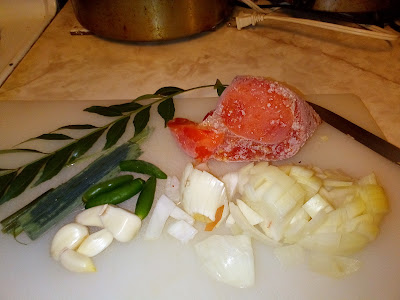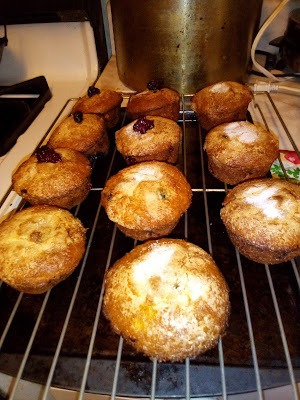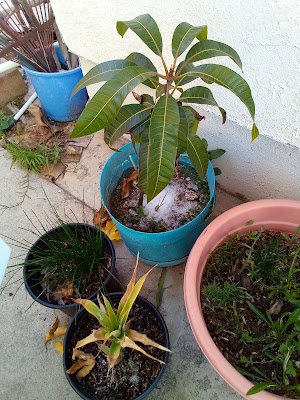 |
| Bless' Chicken Curry |
I have been asked if I had a recipe for curry and considering how often I make chicken curry, I was positive I had posted a recipe earlier, but, when I did a search of my past posts, I didn't find one! So, as I was making a chicken curry for dinner, last night, I thought I will take some photos and write out a few directions.
First, a few side notes:
Curry is the term for a type of dish, just like stew or casserole and just like stew or casseroles, you can have different curries and different ways of preparing the same type of curry. So, my chicken curry is different from my friend's chicken curry and my daughter's chicken curry. Some of the changes are due to the spices other ingredients used as well as the method of cooking (I add tomato to my chicken curry and saute the chicken pieces a bit at first and then, cook them; others don't add tomato or saute the chicken).
Curry is usually made with curry powder, which is a blend of various spices, but, the basics are a blend of coriander, cumin, and fennel. To this basic blend, various other spices are added to make different blends of curry powders. If the ingredients are roasted first before being powdered, you get "roasted curry powder", if they are not roasted, you get "raw curry powder". You can also get something called "dark roasted curry powder" which gives a darker curry powder with a stronger taste and this is usually my favorite blend for the majority of my curries.
I used to buy all the different spices and make my own curry powder, but, that was years ago. These days, I have become lazy and I buy premade curry powders, usually from a Sri Lankan or Indian store.
And finally, when it comes to curries, I don't have a specific recipe that I follow and I don't measure my ingredients. What I have is a method and approximations. It drove my daughter crazy when I first taught her how to cook because I'd say, "Add some curry powder" and she'd ask, "How much?" and I couldn't tell her the specific amounts. So, I'd say, "About this much" and shake some out of the bottle into a dish and she would measure it. These days, she is a more experienced cook and she, too, eyeballs the amounts of curry powder and other ingredients.
Having said all that, here's my chicken curry "recipe":
Ingredients - for each 1 lb. chicken,
1 heaping teaspoon of curry powder (I use a regular teaspoon, not measuring spoons)
1/4 - 1/2 tsp. chili powder/cayenne pepper powder (depends on how hot you want it)
salt to taste
1/4 -1/2 small onion, sliced or chopped
1-2 cloves of garlic, peeled, cut up or left whole
curry leaves, fresh or dried, about 4 or 5 leaves; substitute a bay leaf if you don't have curry leaves or can be omitted, too
1/2 - 1 small tomato - optional (can use canned tomatoes, too)
a few pieces of pandan leaf (I used frozen) - optional
1-2 green chilies (such as serrano peppers) if you like more heat
1 small piece fresh ginger (I didn't have fresh ginger, so used ground ginger)
1 small piece lemon grass - optional (I didn't have lemon grass, so skipped it)
1-2 cardamom pods
1-2 cloves
1 tablespoon of oil (any type of oil; I use vegetable oil)
1/4 - 1/2 cup coconut milk or equivalent (dairy milk, nut milk, oat milk, etc.)
a little lime or lemon juice (I use lemon because that's what I have)
Method:
Add the curry powder, chili powder, and a little salt to the pieces of raw chicken, stir to coat the pieces and leave aside to marinate for 20 to 30 minutes (or longer in the fridge; can be left overnight in the fridge, if you prefer). This step is not an absolute must, but, I like to marinate it a bit before cooking.
 |
| Chicken Pieces Marinating |
While the chicken is marinating, prepare the other ingredients - peel and cut the onion, peel the garlic, cut the tomato, etc. I am using some of the last of my homegrown tomatoes (from the 2021 garden!) that I cut up and froze; I didn't thaw it prior to cooking.
 |
Additional Ingredients: A sprig of curry leaves, a few pieces of
pandan leaves, green chilies, garlic, chopped onion, tomato |
Add a small amount of oil (I used vegetable oil) to the pan you are using to cook the chicken:
 |
| Vegetable Oil in Pan |
Add the curry leaves, pandan leaves (if used), green chilies, cloves, cardamoms, lemon grass (if used) fresh ginger (I used ground ginger and added it to the chicken marinade) and onions to the oil and saute for a minute or so (doing this will flavor the oil), then, add the chicken and the garlic and saute for a few minutes:
 |
| Chicken and Other Ingredients Being Sauteed |
If you choose not to saute, then, add the chicken and other ingredients to a pan with a little bit of water and bring to a boil, covered.
Once the chicken has sauteed for about 5 minutes, I added a little water (about 1/2 cup for this amount of chicken), covered the pan, and let it cook for about 15 minutes or until the chicken is cooked, inside. The chicken will release some water as it cooks and covering the pan will retain the moisture. I stir the chicken once or twice while it cooks, to make sure it is cooking evenly.
 |
| The Chicken As It Cooks |
After it has cooked for about 15 minutes, add the coconut milk (or any other milk of your choice).
 |
| Immediately after the coconut milk was added |
Stir to distribute the milk evenly and bring it to a boil, then, add a little lime or lemon juice. Taste test to see if more salt is needed. If the curry is too spicy, add a little more milk to tone it down a bit.
 |
| Chicken Curry |
This would be served with rice and side dishes of vegetables. Or, with roti or any other type of flat bread. I don't remove the curry leaves or the pandan leaves before serving; if any get on the plate, then, they may be moved to the edge of the plate (curry leaves, however, are edible and are supposed to be very good for you).
This same basic "method" could be used to make any other meat curry. I would, however, add some tamarind to a beef curry (to soften the meat; tamarind can be added to a chicken curry, too, but, I don't).
Today, I made a cashew curry as requested by my daughter. I put the raw cashews to soak overnight (about 3/4 lbs.), then, drained that water, rinsed the soaked cashews, added enough water to cover them, and boiled them with turmeric, salt, curry leaves, chopped onions, a couple of green chilies, and a little bit of raw curry powder. Once they had cooked, I added some coconut milk and lemon juice to it:
 |
| Cashew Curry |
This type of curry would be considered a "white" curry, even though it is yellow in color, because it doesn't have any dried red chili powder to color it red. Potatoes would be cooked in this manner to make a potato curry.
Hope you enjoyed the recipes and maybe try them.














.jpg)
.jpg)









































